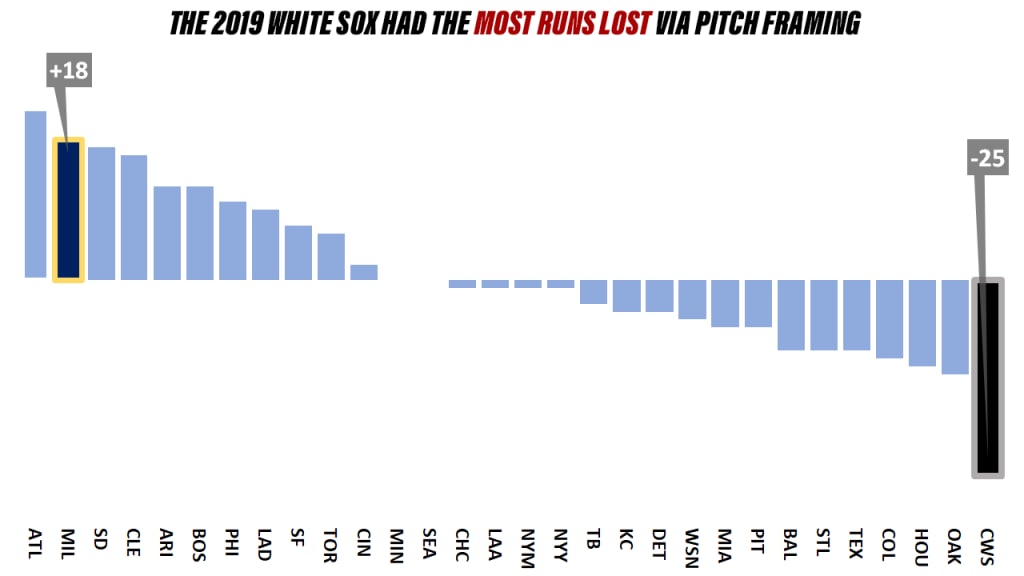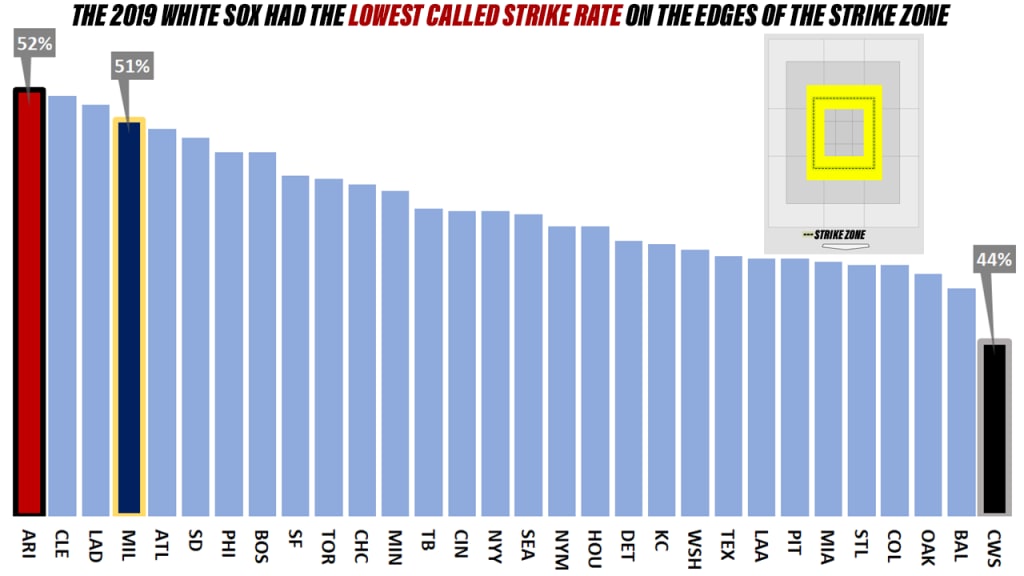The White Sox have made the biggest splash of the offseason so far by signing catcher Yasmani Grandal to a four-year, $73 million contract, successfully completing one of the main steps we suggested weeks ago when we talked about how Chicago could be one of the biggest breakout teams of 2020.
It's not difficult to see how he's going to help the White Sox lineup; he's hit 22 or more homers in four straight seasons, and his .380 OBP/.468 SLG made him the batting equivalent of Tommy Pham or Francisco Lindor in 2019. His 109 walks weren't just the fourth-most in the Majors; they were the seventh-most from a catcher ever.
That part's easy to understand. It's not hard to see what he adds when he's out there crushing go-ahead homers. But what about the value that's not so easy to see -- the value he adds behind the plate with his excellent pitch framing? How might he help a Chicago pitching staff that could desperately use it?
Obviously, the other selling point here is his elite pitch framing, which has also maintained a consistent level of excellence. Grandal was second-best at it in 2019, third-best over the last three seasons, and easily the best -- by a huge margin -- since his 2014 full-season debut. (Numbers can vary on this, but by FanGraphs' reckoning, his framing alone has been worth about 11 wins since 2014, an enormous number.)
That's a big deal, especially because incumbent James McCann was one of the weakest at it. Per Statcast numbers, Grandal saved 13 extra runs by his framing, tied for second-best in baseball, while McCann was minus-16, or last. FanGraphs' numbers differ slightly, but the rankings are similar -- Grandal's plus-17 is second, and McCann's minus-9 is tied for third weakest.
Considering that last year's other primary White Sox catchers, Welington Castillo (minus-8 runs both by Statcast and FanGraphs) and Zack Collins (minus-1 run at Statcast, minus-2 at FanGraphs), were also poor at it, the 2019 White Sox backstops generally hurt their pitchers via framing more than any other team in the game. (We're speaking specifically to framing here, not to non-quantifiable yet probably valuable skills like game calling, which McCann was reportedly strong at.)
We can show you that with two quick images. The first simply shows runs gained or lost on a team basis from framing. Check out where the Brewers, Grandal's 2019 team, ranked compared to the White Sox. This is a gap of over 40 runs, or perhaps four wins, just on framing.

The second is largely the same but takes it off the "framing runs" scale and puts it on a perhaps easier to understand scale of "what percent of takes on the edges of the zone turned into strikes?" This is where about 85% of framing value comes from, with the rest coming from the more obvious areas inside and out of the zone.
The top team, Arizona, and the bottom team, Chicago, each had a nearly identical amount of takes in that area, 4,819 for the D-backs and 4,803 for the White Sox. Yet the D-backs, led by good framing from Carson Kelly and Alex Avila, had over 400 more called strikes there.

This matters, so much. For example, the biggest improvement in 2018-19 framing was from the Reds, who went from minus-22 runs in 2018 to plus-2 in '19. It's not the only reason they went from baseball's seventh-highest ERA to the eighth-lowest -- surely new pitchers like Sonny Gray and new coaches like Derek Johnson had a lot to do with an incredible turnaround -- but it played a part.
It can in Chicago, too. If you look at a list of individual pitchers harmed the most by poor framing, you'll see that three of the top six were White Sox.
-3.0 runs lost -- Reynaldo López, White Sox
-2.1 runs lost -- Ivan Nova, White Sox
-2.0 runs lost -- John Means, Orioles
-1.9 runs lost -- Dylan Bundy, Orioles
-1.8 runs lost -- Sandy Alcantara, Marlins
-1.7 runs lost -- Lucas Giolito, White Sox / Jon Lester, Cubs / Lance Lynn, Rangers
On the other end of that list, three of the six pitchers helped the most by good framing were Brewers, Zach Davies (+3.0 runs), Brandon Woodruff (+1.9 runs), and Adrian Houser (+1.9 runs). At the extremes, six runs are about a half-a-WAR, just through the help of a catcher, and that probably doesn't even fully account for the benefits of fewer pitches thrown, fewer times behind behind in the count, and so on.
If you really want to see what that looks like in action, we found videos of two nearly identical pitches with different outcomes.
On May 28 in Minnesota, Davies threw a low-and-away changeup to a lefty hitter, right on the corner of the zone, 1.59 feet above the ground, framed by Grandal for a strike.
Three days later in Chicago, Nova threw a low-and-away changeup to a lefty hitter, right on the corner of the zone, 1.59 feet above the ground, which McCann was unable to turn into a strike.
Davies would go on to throw six shutout innings at a Twins team that broke the all-time record for home runs.
So, what kind of impact could this have on the White Sox? Remember, this wasn't just about 2019, because the Sox had a similar issue in '18 -- Omar Narváez, the primary catcher that year before he was dealt to Seattle in November, was the second-weakest framer at minus-13 runs.
Let's go back again to the Reds, specifically Luis Castillo, who went from being hurt by minus-2.4 runs (2018) to helped by plus-0.6 (2019). His strikeout rate jumped from 23% to 29%; his ERA dropped from 4.30 to 3.40. On those taken pitches on the edges of the zone we referred to above, he went from getting 43% of them being called strikes to 47%, or 41 extra strikes. It's not just about that, obviously, because Castillo was, by all indications just better. He threw more changeups, and he threw his fastball harder. It's not just framing, but it's also a little about framing.
Imagine, for example, if Grandal could have the same impact on López, who had a 5.38 ERA in 2019, throwing primarily to Castillo. Imagine what he could do for reliever Jace Fry, who seemed like he might be on the verge of a breakout in 2018 before seeing his percentage of called strikes on the edges collapse from 52% to 38% -- and his walk rate nearly double from 9% to 17%. Imagine how Giolito's breakout season could look even better if he threw fewer than 100% of his pitches to McCann, as he did in 2019.
“Yasmani was absolutely toward the top of our list in terms of offseason priorities,” White Sox general manager Rick Hahn said. “Obviously he was someone we acted on quickly.”
They sure did, and with good reason. Grandal is going to help the lineup, considerably. He might help the pitching just as much.
